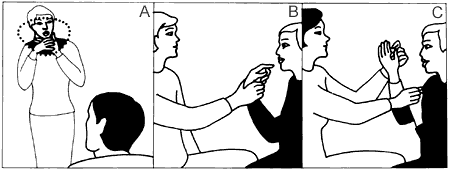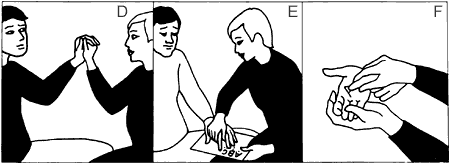Different Types of Communication used by Deafblind Patients
Although the total number of deafblind patients is small, the number of different communication systems used by them is surprisingly large. This is naturally related to the many different types and degrees of deafblindness. If we consider the time of onset of the impairments we get nine different categories of deaf blindness:
- born deaf:
- blind from birth
- visually impaired with some useful vision in childhood
- visually normal or nearly normal as a child, impaired later
- born hard-of-hearing:
- blind from birth
- visually impaired with useful vision as a child
- visually normal as a child, impaired later
- born with normal hearing, hearing loss later:
- blind from birth
- visually impaired with useful vision as a child
- normal sight as a child, both impairments later.
Each of these combinations has a different effect on language and cognitive development. Therefore, when dealing with a deafblind person we should be aware of the time of onset of both impairments. We should also have information on the early habilitation and language development of the child. In the case of deaf children, the very early months of language development are crucial for spoken language and speech. The later the loss of social hearing occurs, the better possibilities there are for intelligible speech. In addition, the type of communication used during pre-school and school years affects communication greatly if a deaf person later loses most of his visual field.

Figure 3. A. Visual sign language modified to use smaller than normal signs at greater than normal distance in order to place the signs within the limitedfield of the patient. B. Tactile signing means regular sign language that the blind person perceives tactually. In the beginning it is two-handed and therefore cumbersome in an examination because the interpreter has to face the patient during communication. Later it becomes one-handed and does not interfere with examination. C. The combination of visual and tactile information is called tracking. The person observes the hand of the interpreter tactually while watching the hand movements also visually.

D. The one-hand manual alphabet looks to an uninformed observer almost the same as one-handed signing, but the information is finger spelled tactually on the palm of the patient. E. The braille alphabet card can be used by anyone if the patient knows braille. This card should be available in all emergency units to facilitate communication with a blind braille user who cannot hear well enough with his hearing aid or who may have lost it in an accident. F. Block printing, the writing of regular capital letters on the palm or forearm of the person is always available. It takes time but is very effective in emergency situations because the physical contact with the signer reassures the patient.
Although the oral method of teaching was perceived as a punishment by many children, those who learned to lip read well and later suffered from visual impairment were much better off with their 4-5 degree visual field at 45-50 years of age than were similarly impaired persons who never learned to lip read. This is not to say that I would recommend forced lip reading for deaf children at the expense of teaching sign language. What I am saying, however, is that deaf or hard-of-hearing children with retinitis pigmentosa should get more training in lip reading than visually normal deaf children because their ability to communicate later in life will be greatly improved. It is generally much easier to learn lipreading as a child, although not all children develop that ability. Before training there should be thorough assessment of recognition and copying of lip movements. This is not available in most countries and would be an important test to develop, especially for congenitally deaf children but also for patients with brain damage.
Deafblindness is often related to additional impairments that complicate communication and the acquisition of language. If the additional neurological impairment develops later, it may make expressive or receptive language unusual and difficult to understand. The deaf blind patient may also have motor impairments that affect the production of speech or signs, even though the understanding of language may be normal. Some patients function below age appropriate cognitive levels because of sensory deprivation or because of brain damage.
In terms of language, basically we have two large groups of deafblind individuals: those who have normal language level (in ASL or English) and those who have limited language. When examining the first group of patients we use techniques used during routine visual assessment, although we must pay extra attention to the physical difficulties of communicating. When examining persons with limited communication we have to rephrase our questions, limit them to a minimum, and rely often on methods that we usually use in the examination of infants and young children.
Deafblind individuals with normal language level (in ASL or English) use more than half a dozen different modes of communication.
- Techniques based on ASL:
- visual sign language modified to fit the visual impairment
- tactile sign language.
- Techniques based on written language:
tactile manual alphabet, in the United States one-handed (more rare are the alphabet glove, the British two-handed alphabet, and the Central-European Lorm alphabet)
braille, either by using a braille alphabet card, printing on the palm, or via Tellatouch, VersaBraille, Dialogos, or Dotless Braille
- block printing of capital letters on the palm
- morse code
written information, normal or large print, sometimes via CCTV, Viewscan or by using different techniques to enlarge the text on the computer screen
- S. Dexter, mechanical fingerspelling hand
Glove with sensors that convert finger spelling to text on a computer or to synthetic speech.
- Tadoma method, tactile reading of movements of lips and larynx.
Visual and tactile sign language are used by persons who learned sign language as their mother tongue. Some visually impaired patients who lose hearing in adulthood become fluent enough with signs to communicate with deaf persons. When communicating with hearing persons, these late onset deaf persons can use the quite good speech they usually have retained.
The manual alphabet is most frequently used by persons who are born deaf or hard of hearing. The use of finger spelling varies in different deaf populations. Many older deaf persons use finger spelling more than is customary in younger ASL users. Reception of finger spelled information is difficult visually and it is still harder tactually. There are different techniques in receiving the manual alphabet. If a person experiences more than normal difficulty in learning to receive the manual alphabet, different hand positions should be suggested in order to try out different haptic constellations.
Since it is difficult to learn to read braille as an adult, only a limited number of deafblind persons use braille information. It is common among persons who lost their sight early and also learned braille early. Braille information requires good language skills and good tactile sensation in the fingertips. The numerous contractions of words are often problematic to anyone who has learned English as a second language.
Dotless Braille refers to a device which uses a keyboard resembling a regular braille writer. However, the keys are also used for reception and pop up in the usual letter configurations when the keyboard is used for receiving messages.
Block printing should be remembered as a method of communication in emergency situations such as when a deaf person, who has previously lost central vision in one eye, develops macular haemorrhage in the good eye. The person cannot perceive signed information and cannot read instructions except, perhaps, on a CCTV. Most often the patient can calm down and receive information if it is slowly printed on the palm of the hand. It must be remembered that the sentences first have to be short and the vocabulary limited to the most common words, if there is no information available on the patient's language level.
Hard of hearing patients who have lost their hearing aids are a special problem. Block letters printed on the patient's palm can also be used in this situation. Another often forgotten technique is amplification using a cylinder made out of the glossy cover of a journal.
Roll a journal to a tube of about two inches and place it against the patient's ear.
Speak slowly and clearly into the tube, using a lower than usual pitch and you will be surprised to see how well many "deaf" patients can hear.
Written information should be used sparingly when dealing with ASL users and it should be written at the language level of the patient. Written information is, however, important as a part of drawings to clarify diagnostic procedures, anatomical structures, new concepts, etc. Since written information is slow, it is not acceptable as a sole communication method if the patient can use a more fluent type of communication. Communication cards for frequently used sentences, questions and instructions should be available in emergency situations when the first-aid personnel has to be able to communicate with the patient before the interpreter arrives.
When I meet with a deafblind patient with limited communication for the first time, I ask the following "do-we-know" questions about communication and learning. Do we know:
when the hearing impairment started affecting the two functions
what was done in early habilitation (if pertinent to the case)
how communication developed during school age
what other neurologic deficits may affect communication
what is the language level (ASL and/or English) of the patient
who defined it and when
whether we have missed some crucial information about the past or present situation
how much variation there is in the level of communication with different persons
whether there has been a recent change in either hearing or vision resulting in a period of readjustment and learning, e.g. a transition from visual to tactile sign language?